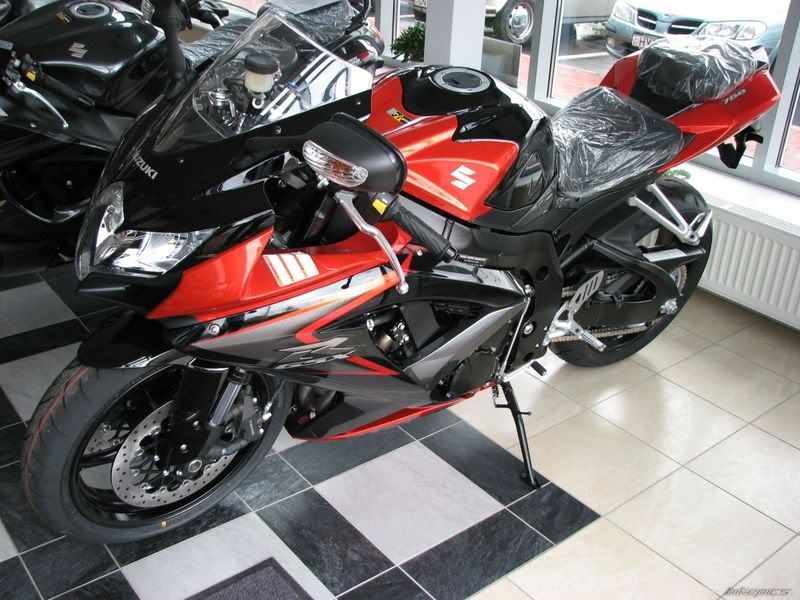
Suzuki GSX-R600/GSX-R750
Almost identical twins get gussied up for '08.
As expected, Suzuki announced its new GSX-R600 and 750 models at the Paris Motorcycle Show this past week. With virtually all-new versions of these Suzuki sportbikes debuting in ’06, these ’08s are mostly cosmetic revisions with minor mechanical upgrades. Sharing a common platform, many of the changes to the two bikes are in parallel with each other, including the addition of Suzuki’s Drive Mode Selector (S-DMS) as first seen on the 2007 GSX-R1000.
The obvious alteration comes in the form of new styling. Up front is an attractive nose job that gives the bikes a more contemporary look. It also appears wider, which should increase weather protection for the rider, and it juts out further forward than previous. A center-mounted low-beam is flanked by a pair of high-beams, with the pair of ram-air inlets mounted directly below to maximize their effect. Also new are the front turnsignals integrated into the mirrors like the Gixxer Thou flagship.
Perhaps the most controversial styling treatment is the massive new exhaust system. Instead of last year’s stubby tailpipe, this new treatment stretches from the under-engine collector into a large canister that sweeps all the way past the bike’s rear axle. Its awkward large size helps the bike meet new stringent exhaust emissions requirements. We expect the aftermarket to sell a boat-load of replacement pipes for these Gixxers. Like before, it includes an exhaust valve that optimizes torque and horsepower production based on throttle opening and engine speed.
In the Gixxer 600’s engine room, Suzuki engineers have made several tweaks, concentrated mostly in the cylinder head. Intake ports have been smoothed, and the combustion chamber has a new shape said to reduce shrouding of the intake valves at low lift for optimized cylinder charging. Inlet and exhaust valves are titanium in the same 27.2mm and 22mm sizes as before. New forged-aluminum pistons help increase the compression ration slightly to 12.8:1.
The 599cc inline-Four engine is architecturally similar to last year, using the same bore and stroke with an identical 16,000-rpm rev limit. The piston’s pumping power losses are diminished by larger ventilation holes between the cylinders. Igniting the fuel-air mixture are new 10mm iridium-tipped plugs and a smaller plug-top ignition coil on each cylinder.
A tinier, 32-bit ECU keeps track of a plethora of parameters for the best engine response, as well as controlling the switchable S-DMS for different power curves. Selected from a handlebar-mounted switch, it features three modes: full power; limited power; and significantly neutered output.
As before, the Gixxers use Suzuki’s Dual Throttle Valve (SDTV) fuel-injection setup. The intake mixture is fed by injectors that that now feature eight small holes instead of last year’s four to improve atomization for a more complete burn.
Not much change to the transmissions. They still feature a back-torque-limiting design, but the magnesium clutch cover and oil pan now have revised internal ribbing to reduce mechanical noise.
The GSX-R’s chassis and its geometry remain mostly unchanged. The exception is the bikes’ subframes, which are now constructed of die-cast aluminum to pare a scant 125 grams from their weight. The fuel tanks have a slight increase in capacity to 4.5 gallons. The Gixxer 600 is said to have a dry weight of 359 pounds, a weight penalty of an extra 5 pounds over last year’s version.
Showa suspension components are used front and rear, both adjustable for preload and compression/rebound damping; the shock still has separate circuits for high- and low-speed compression damping. Also remaining adjustable are the three-position footpegs that we’ve appreciated on previous iterations.
The GSX-R’s front brakes are still four-piston Tokico calipers that feature differential-bores. Rotor sizing remains at 310mm, but they are now 0.5mm slimmer at 5.0mm thick for slightly less rotating mass. This concept is carried to the new Gixxer wheels: the fronts are now 180 grams lighter, while the rears have a 250-gram weight reduction.
GSX-R750
The mid-sized Gixxer features most of the upgrades seen on the littler 600, although the 749cc mill hasn’t as many changes. It, too, has the larger ventilation holes between the cylinders to reduce pumping losses, but the motor seems otherwise stagnant in its specifications.
The GSX-R750 also receives the 600’s styling updates, new ECU and its S-DMS power-mode selector, as well as the controversial exhaust system. It also has the upgrades to the brakes, wheels, fuel injectors and spark plugs. It has a claimed dry weight of 364 pounds, just 5 more than the 600.
GSX-R600 Specifications
Engine Type: 4-cylinder, inline, 4-stroke, liquid-cooled, DOHC
Bore x Stroke: 67.0mm x 42.5mm
Engine Displacement: 599cc
Compression Ratio: 12.8:1
Transmission: 6-speed constant mesh
Primary Drive Ratio: 1.977 (77 / 39)
Final Drive Ratio: 2.687 (43 / 16)
Frame Type: Twin-spar diamond (aluminum-alloy)
Rake/Trail: 23.8 degrees / 98mm (3.9 in.)
Suspension, front: Inverted telescopic, coil spring, oil damped, spring preload fully adjustable, rebound and compression damping force fully adjustable
Suspension, rear: Link type, coil spring, oil damped, spring preload fully adjustable, compression damping 2-way fully adjustable, rebound damping fully adjustable
Wheels, front: 17 x 3.50, cast aluminum-alloy
Wheels, rear: 17 x 5.50, cast aluminum-alloy
Brakes, front: Radial mount, 4-piston calipers, 310mm disc, twin
Brakes, rear: 1-piston caliper, 220mm disc
Tires, front: 120/70ZR17 (58W), tubeless
Tires, rear: 180/55ZR17 (73W), tubeless
Fuel tank: 17.05 liters (4.5 U.S. gal.)
Overall length: 2,040 mm (80.3 in.)
Overall Width: 715 mm (28.1 in.)
Overall height: 1,125 mm (44.3 in.)
Wheelbase: 1,400 mm (55.1 in.)
Seat height: 810 mm (31.9 in.)
Dry weight: 163 kg (359 lbs.)







